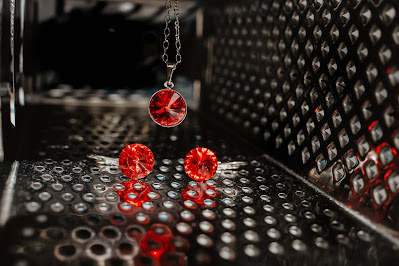The Rising Popularity of Rare Gemstones


The Proustite gem is sometimes mistaken for a ruby due to its similar look to a ruby stone. It is one of the rarest gems globally, with colours ranging from red to slightly pale reddish. Its lustre is unique and metallic-like, sometimes called 'silver ruby.'
 |
| Proustite jewellery |
Proustite is good for many things other than jewellery making. They possess silver which poses a risk of irreversible photochromic effect if worn. Their low hardness of 2-2.5 on the Mohs scale makes them not an option for jewellery. This means they are vulnerable to several scratches, even from simple household objects. They are not good for strong light since the stone turns black due to light exposure.
(Proustite | Rock & Gem Magazine, 2019) stated that exposure to light that leaves the stone dull or black makes it not a choice for jewellery. This means that when its beauty fades away, the owner will likely get bored of it.
Proustite stone might be similar to pyrargyrite; however, Proustite is far rarer than pyrargyrite in jewellery making, especially in faceted gems.
With the presence of arsenic, dust from this gem, especially when being faceted, should be avoided since it is harmful when ingested. Swallowing or putting the gem in your mouth or leaking your silver onto the gem while conducting local gem tests should be avoided.
However, Joel E. Arem, Ph.D., FGA, argued in his article Proustite Value, Price, and Jewelry Information that there should be no health risks in wearing or touching fully finished proustite gems.
The stone might have portions of silver which might pose a risk of irreversible photochromic effect (Amber Value, Price, and Jewelry Information, n.d.).
(Arem, 2022) wrote that the stone is made of a shiny red streak that makes it remarkable from other gems. Testing the streak on the gem isn't advisable on finished proustite gems. The stone should be adequately tested in sensitive areas in case of identification.'
Proustite crystals become dull black and opaque if exposed to light for longer periods. Most of the crystals are opaque or translucent though their transparency differs from specimen to specimen.
Proustite has a unique law of definite proportion where chemical compounds often gather in constant proportions. This was discovered by Joseph-Louis Proust (September 26, 1754, Angers, France – July 5, 1826, Anger, France).
Proustites are also among the few gems that aren't fully synthesized, and there are traces of ideas about the stones' treatments or enhancements.
When exposed to light, Proustite's dull or black colour can easily be eradicated with proper brushing of the stone with soap and water, so it is nothing to worry about.
The crystal has a specific gravity of 5.57 (g/cm3) and a refractive index of 2.792 - 3.088 uniaxial (-0). It has an attractive adamantine lustre that is good for viewing.
The blackening that occurs when a proustite is exposed to light for a long period can occasionally leave an irreversible photochromic effect that might affect the stone's quality. That is why it is recommended that the stone should be stored in dark places with limited light exposure (Arem, 2022).
It is also nicknamed "the blood of the bull" due to its uniquely attractive colour. The name happened in Chile and Chanarcillo, and it is often used when the gems are found in quantity as "Sangre de Chile."
Synthetic proustites are made for research-related solutions through optic mixing and lasers. The same method is used to treat or enhance the gems.
Comments
Post a Comment
Thanks for commenting. Here at Gems Essence, we're glad that you are part of us.